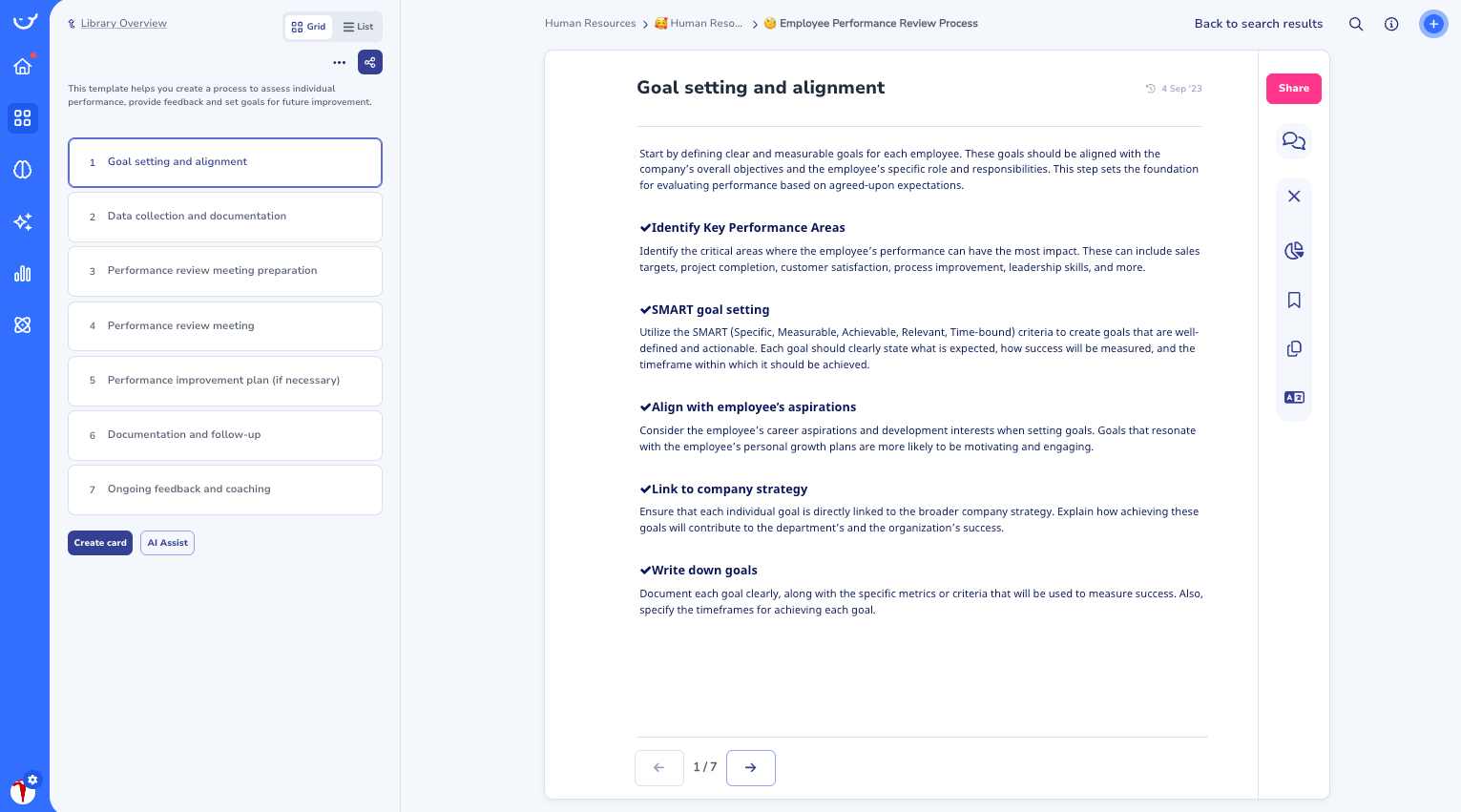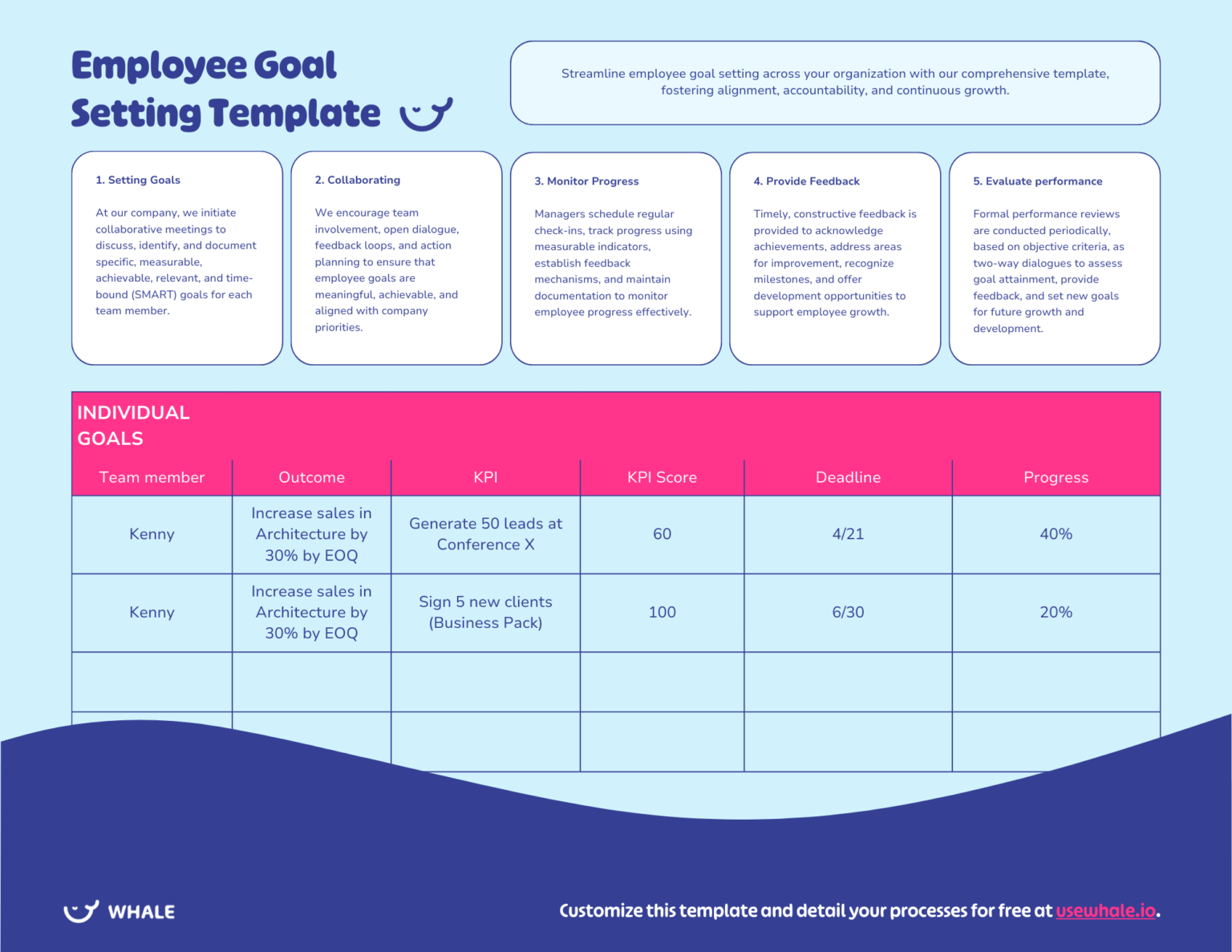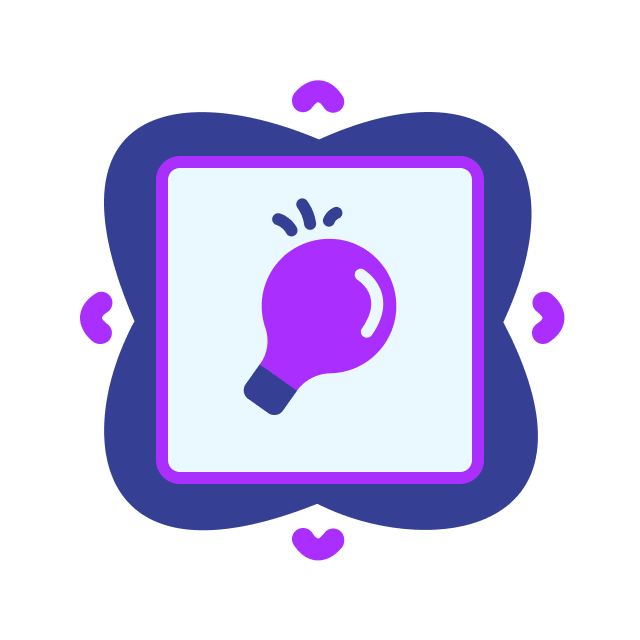For entrepreneurs and growing businesses, understanding the ins and outs of goal setting can be the difference between spinning your wheels and achieving your business growth metrics.
The employee goal setting template is your go-to guide for introducing goal setting within your organization, designed to help you and your employees achieve and surpass your business aspirations.
What is goal setting?
Think of goal setting as crafting a personalized success map for each member of your team. It involves identifying targets that are not only ambitious but also clear, measurable, and tailored to drive your company forward.
When done right, it creates a powerful alignment between individual efforts and your overall business strategy, boosting productivity and fostering an environment ripe for success.
PS Another word for goal setting can be objectives or rocks, although rocks are generally bound by 90 days.
Why employee goal setting matters? 🎯
Employees with goals are 3.6 times more likely to be committed to their organization and 80% of employees who set goals at work feel like their ideas are taken seriously, leading to increased engagement. (BiWorldwide)
Why? Because goal setting results in
- Alignment with Bigger Picture: It ensures that everyone’s work pushes in the same direction—towards your business vision.
- A boost in motivation: When employees see how their efforts add up to something significant, engagement skyrockets. Statistics show that employees who find their work meaningful are far more likely to stick around .
- Performance insights: Regular goal reviews open the door to ongoing feedback, helping people grow and excel in their roles.
- Professional development: Achieving set goals means employees are constantly picking up new skills and prepping for bigger challenges, which keeps the future bright for everyone involved.
Ian MacLeod on Setting Employee Goals
Use our templates to fast-track your documentation
Customize this template and 100s of others for free in Whale, the fastest way to get your team aligned.
Types of employee goals
Setting varied and balanced goals can cover all aspects of an employee’s role and growth within your organization. Here’s a breakdown of different types of goals you might consider:
Employee Performance Goals
The focus on performance goals is on results!
These goals are all about enhancing job performance. Examples include increasing output, improving product quality, or reducing error rates. They are often quantifiable and tied directly to business outcomes, making them essential for measuring success in role-specific tasks.
Career Goals
Career goals focus on the long-term vision of the team member and their career objectives.
Career goals focus on the employee’s progression within the company. This could involve advancing to a higher role, mastering new skills required for a promotion, or leading a major project. These goals help employees visualize their future with the company and motivate them to align their efforts towards long-term achievements.
Soft Skills Goals
Soft skills goals help the team member develop certain characteristics which will assist them in their work and even in their personal life.
These goals emphasize improving interpersonal skills, such as communication, leadership, and time management. For instance, an employee might aim to enhance their public speaking skills or develop better conflict resolution strategies. Soft skills are increasingly valued in the workplace as they facilitate better teamwork and adaptability.
Collaboration Goals
Enhancing collaboration skills is all about aligning teams to work better together to achieve common goals.
Collaboration goals are set to improve how employees work together. Objectives might include increasing the efficiency of team meetings, enhancing cross-departmental projects, or fostering a more inclusive team culture. These goals are crucial for ensuring that teams are more than just groups of individuals working under the same roof—they are cohesive units that achieve more together.
By incorporating a mix of these goal types, you can ensure that your employee development is comprehensive, addressing aspects from immediate job performance to long-term career aspirations and interpersonal growth.
This holistic approach not only advances individual capabilities but also enhances the collective strength of your team.
How to set goals with employees?
How can you make setting goals with your team for a smooth and inclusive ride?
Go SMART
Make your goals specific, measurable, achievable, relevant and time-bound. These are the hallmarks of goals that get results.
Make it a team sport
Involve your employees in the goal-setting process. It’s a fantastic way to ensure the goals resonate with them personally and professionally.
Keep the conversation going
Regular check-ins keep everyone on track and allow you to tweak goals as needed.
Empower your teams
Accountability and ownership keep people empowered. Make sure your teams have the tools and support needed to chase down those goals and then allow them to take accountability for the results.
Celebrate the wins 🙌
Big or small, every achieved goal deserves a cheer—it boosts morale and motivates everyone to reach for more. In the Whale office, we have a screen depicting our milestones but you could use a bell or even rewards like team lunches to celebrate the wins.
Examples of Employee Goals
Whether you’re a tech startup or a seasoned retailer, here are some goal examples that can be tailored to fit your team’s needs:
- Boost sales by 15% this quarter: A crystal-clear target for your sales squad.
- Elevate customer satisfaction by 20%: This goal could make your customer service team the stars of the company.
- Finish leadership training by year-end: Perfect for anyone eyeing a management role.
- Cut down project delivery times by 10% by December: A great goal for your operations team to streamline processes.
Did you notice how each of these examples has a specific number or measurable in place? And is also accompanied by a deadline?
SMART goals are the only way to really make an impact with goal setting.
How to help employees achieve their goals?
Setting goals is just one part of the success equation. Meeting and achieving those goals is another.
Here are 5 ways to help employees achieve their goals;
- Hold one-on-one meetings with team members
- Host a daily standup
- Have each team member report on their progress weekly in the Level 10 meeting
- Create a culture of learning
- Celebrate the wins – although this is one way to set goals, it’s also a surefire way to achieve them
FAQs on employee goal setting
What is an example of a measurable goal for an employee?
The best example of a measurable goal for an employee is one that is SMART!
Specific, Measurable, Achievable, Realistic, and Timely.
Here are two examples;
- For a Marketing Manager: Boost website traffic by 30% in the next 4 months by focusing on social media and SEO. This goal is specific (increase traffic), measurable (30% increase), achievable (with targeted strategies), relevant (to marketing), and time-bound (four months).
- For an HR Specialist: Implement a new employee onboarding process by the end of Q3, aiming to increase new hire retention rates by 30%. This goal is specific (new onboarding process), measurable (30% retention increase), achievable (with a new process), relevant (to HR), and time-bound (by the end of Q3).
What happens if an employee doesn't want to set goals?
If goal setting isn’t met with enthusiasm, consider it an opportunity for dialogue:
- Discuss the benefits: Share how goal setting can be incredibly rewarding, paving the way for personal and professional growth.
- Listen actively: Sometimes, all it takes to turn the tide is a heartfelt conversation about their concerns and how you can address them.
- Reassure and support: Make it clear that these goals are tools for development, not yardsticks for punishment.
- Start small: Ease them into the process with smaller, manageable goals to help them see the value without feeling overwhelmed.
- Set training objectives: By embarking on training, employees can feel more confident to achieve their objectives.
How often should employee goals be reviewed?
Frequency matters, and regular reviews are crucial.
Aim for quarterly reviews to assess progress, provide feedback, and make adjustments. This keeps goals relevant and employees motivated. For more dynamic roles or projects, even monthly check-ins can be beneficial to stay agile and responsive.
What if an employee consistently misses their goals?
Always take a constructive approach. First, seek to understand the reasons a team member is missing their goals — Is it a lack of resources? Unrealistic goals? External factors?
Once you identify the barriers, work together to find solutions. Perhaps adjusting the goals or offering additional support and training could turn things around. Remember, the goal is growth and improvement, not just ticking boxes.
Armed with this template, you’re now ready to harness the full power of goal setting in your business. Remember, each goal your team sets and achieves is not just a step forward in their careers but a leap towards your collective success.
Use our templates to fast-track your documentation
Customize this template and 100s of others for free in Whale, the fastest way to get your team aligned.




